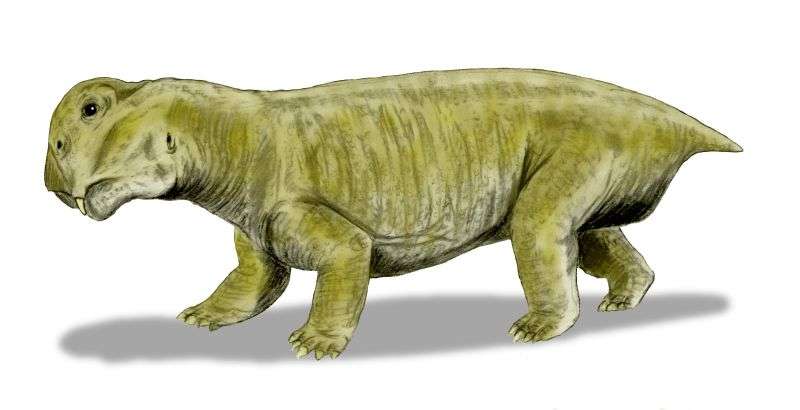Lystrosaurus was by far the most abundant early Triassic land vertebrate. Credit: Nobu Tamura/Wikipedia/CC BY 3.0
(Phys.org)—Paleontologist and evolutionary biologist Steven Stanley of the University of Hawaii has challenged the notion that the Permian-Triassic mass extinction event 252 million years ago killed off up to 96 percent of all marine life. Instead, he claims in his paper published in Proceedings of the National Academy of Sciences, that background extinctions should account for some of that loss, and because of that, the actual extinction rate for marine life was probably closer to 81 percent.
The Permian-Triassic mass extinction lasted for approximately 60,000 years, and was undoubtedly a tough time for the creatures that lived back then—prior research has suggested that there was an unusually large amount of volcanic activity and also possibly multiple large asteroid impacts, which together caused the planet to warm, and also resulted in an increase in ocean acidification—the conditions were so harsh that many species on land and in the sea went extinct. But, Stanley argues, it was not bad enough to wipe out most marine life entirely, as some have suggested. He points out that most extinction estimates for the period fail to include background extinctions, which are extinctions that occur between mass extinctions—they tend to occur as a species runs up against a situation it cannot overcome, such as a new predator, a change in water supply, etc.
Stanley studied the numbers of species that went extinct between known mass extinction events and found a correlation with their numbers and the length of time that passed—the longer the period, the more background extinctions. He then applied the same logic to the time span prior to the Permian-Triassic mass extinction and found that many of the species believed to have gone extinct during the great dying would have actually died out, statistically speaking, before it occurred or would have died during the event anyway. Subtracting those species from the numbers believed to have disappeared brought the percentage down to 81 percent—which Stanley notes is still substantial; it was just not as calamitous as thought. He further suggests that 90 orders and 220 families of marine life survived the mass extinction event and that the factors leading to the extinctions were much more difficult to overcome for some orders and classes than others, which meant that there were disproportionate numbers of losses. Some likely were never close to extinction, he suggests.
More information: Steven M. Stanley. Estimates of the magnitudes of major marine mass extinctions in earth history, Proceedings of the National Academy of Sciences (2016). DOI: 10.1073/pnas.1613094113
Abstract
Procedures introduced here make it possible, first, to show that background (piecemeal) extinction is recorded throughout geologic stages and substages (not all extinction has occurred suddenly at the ends of such intervals); second, to separate out background extinction from mass extinction for a major crisis in earth history; and third, to correct for clustering of extinctions when using the rarefaction method to estimate the percentage of species lost in a mass extinction. Also presented here is a method for estimating the magnitude of the Signor–Lipps effect, which is the incorrect assignment of extinctions that occurred during a crisis to an interval preceding the crisis because of the incompleteness of the fossil record. Estimates for the magnitudes of mass extinctions presented here are in most cases lower than those previously published. They indicate that only ∼81% of marine species died out in the great terminal Permian crisis, whereas levels of 90–96% have frequently been quoted in the literature. Calculations of the latter numbers were incorrectly based on combined data for the Middle and Late Permian mass extinctions. About 90 orders and more than 220 families of marine animals survived the terminal Permian crisis, and they embodied an enormous amount of morphological, physiological, and ecological diversity. Life did not nearly disappear at the end of the Permian, as has often been claimed.
Journal information: Proceedings of the National Academy of Sciences
© 2016 Phys.org























